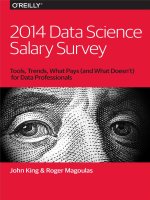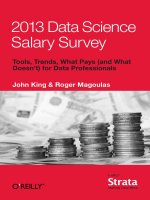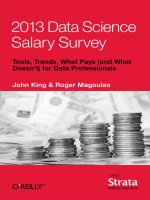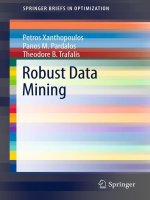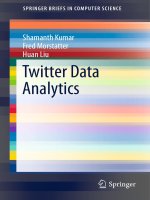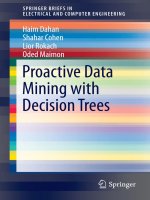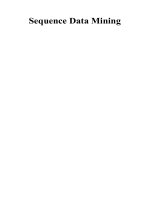IT training 2014 data science salary survey khotailieu
Bạn đang xem bản rút gọn của tài liệu. Xem và tải ngay bản đầy đủ của tài liệu tại đây (5.22 MB, 33 trang )
2014 Data Science
Salary Survey
Tools, Trends, What Pays (and What Doesn’t)
for Data Professionals
John King & Roger Magoulas
Take the Data Science
Salary and Tools Survey
As data analysts and engineers—as
professionals who like nothing better than
petabytes of rich data—we find ourselves in a
strange spot: We know very little about ourselves.
But that’s changing. This salary and tools survey
is the second in an annual series. To keep the
insights flowing, we need one thing: People like
you to take the survey. Anonymous and secure,
the survey will continue to provide insight into the
demographics, work environments, tools, and
compensation of practitioners in our field.
We hope you’ll consider it a civic service. We hope
you’ll participate today.
Make Data Work
strataconf.com
Presented by O’Reilly and Cloudera,
Strata + Hadoop World is where
cutting-edge data science and new
business fundamentals intersect—
and merge.
n
n
n
Learn business applications of
data technologies
Develop new skills through
trainings and in-depth tutorials
Connect with an international
community of thousands who
work with data
Job # 15420
2014 Data Science
Salary Survey
Tools, Trends, What Pays
(and What Doesn’t) for Data
Professionals
John King and Roger Magoulas
2014 Data Science Salary Survey
by John King and Roger Magoulas
The authors gratefully acknowledge the contribution of Owen S. Robbins and
Benchmark Research Technologies, Inc., who conducted the original 2012/2013
Data Science Salary Survey referenced in the article.
Copyright © 2015 O’Reilly Media, Inc. All rights reserved.
Printed in the United States of America.
Published by O’Reilly Media, Inc., 1005 Gravenstein Highway North, Sebastopol, CA
95472.
O’Reilly books may be purchased for educational, business, or sales promotional use.
Online editions are also available for most titles ( ). For
more information, contact our corporate/institutional sales department:
800-998-9938 or .
November 2014:
First Edition
Revision History for the First Edition
2014-11-14: First Release
2015-01-07: Second Release
While the publisher and the author(s) have used good faith efforts to ensure that the
information and instructions contained in this work are accurate, the publisher and
the author(s) disclaim all responsibility for errors or omissions, including without
limitation responsibility for damages resulting from the use of or reliance on this
work. Use of the information and instructions contained in this work is at your own
risk. If any code samples or other technology this work contains or describes is sub‐
ject to open source licenses or the intellectual property rights of others, it is your
responsibility to ensure that your use thereof complies with such licenses and/or
rights.
9781491918425
[LSI]
Table of Contents
2014 Data Science Salary Survey. . . . . . . . . . . . . . . . . . . . . . . . . . . . . . . 1
Executive Summary
Introduction
Salary Report
Tool Analysis
Regression Model of Total Salary
Conclusion
1
2
5
10
19
25
v
2014 Data Science Salary Survey
Executive Summary
For the second year, O’Reilly Media conducted an anonymous sur‐
vey to examine factors affecting the salaries of data analysts and
engineers. We opened the survey to the public, and heard from over
800 respondents who work in and around the data space.
With respondents from 53 countries and 41 states, the sample cov‐
ered a wide variety of backgrounds and industries. While almost all
respondents had some technical duties and experience, less than half
had individual contributor technology roles. The respondent sample
have advanced skills and high salaries, with a median total salary of
$98,000 (U.S.).
The long survey had over 40 questions, covering topics such as
demographics, detailed tool usage, and compensation. The report
covers key points and notable trends discovered during our analysis
of the survey data, including:
• SQL, R, Python, and Excel are still the top data tools.
• Top U.S. salaries are reported in California, Texas, the North‐
west, and the Northeast (MA to VA).
• Cloud use corresponds to a higher salary.
• Hadoop users earn more than RDBMS users; best to use both.
• Storm and Spark have emerged as major tools, each used by 5%
of survey respondents; in addition, Storm and Spark users earn
the highest median salary.
• We used cluster analysis to group the tools most frequently used
together, with clusters emerging based primarily on (1) open
source tools and (2) tools associated with the Hadoop ecosys‐
1
tem, code-based analysis (e.g., Python, R), or Web tools and
open source databases (e.g., JavaScript, D3, MySQL).
• Users of Hadoop and associated tools tend to use more tools.
The large distributed data management tool ecosystem contin‐
ues to mature quickly, with new tools that meet new needs
emerging regularly, in contrast to the silos associated with more
mature tools.
• We developed a 27-variable linear regression model that pre‐
dicts salaries with an R2 of .58. We invite you to look at the
details of the survey analysis, and, at the end, try plugging your
own variables into the regression model to see where you fit in
the data world.
We invite you to take a look at the details, and at the end, we
encourage you to plug your own variables into the regression model
and find out where you fit into the data space.
Introduction
To update the previous salary survey we collected data from October
2013 to September 2014, using an anonymous survey that asked
respondents about salary, compensation, tool usage, and other dem‐
ographics.
The survey was publicized through a number of channels, chief
among them newsletters and tweets to the O’Reilly community. The
sample’s demographics closely match other O’Reilly audience dem‐
ographics, and so while the respondents might not be perfectly rep‐
resentative of the population of all data workers, they can be under‐
stood as an adequate sample of the O’Reilly audience. (The fact that
this sample was self-selected means that it was not random.) The
O’Reilly data community contains members from many industries,
but has some bias toward the tech world (i.e., many more software
companies than insurance companies) and compared to the rest of
the data world is characterized by analysts, engineers, and archi‐
tects who either are on the cutting edge of the data space or would
like to be. In the sample (as is typical with our audience data) there
is also an overrepresentation of technical leads and managers. In
terms of tools, it can be expected that more open source (and
newer) tools have a much higher usage rate in this sample than in
the data space in general (R and Python each have triple the num‐
2
|
2014 Data Science Salary Survey
ber of users in the sample than SAS; relational database users are
only twice as common as Hadoop users).
Our analysis of the survey data focuses on two main areas:
1. Tools. We identify which languages, databases, and applications
are being used in data, and which tend to be used together.
2. Salary. We relate salary to individual variables and break it
down with a regression model.
Throughout the report, we include graphs that show
(1) how many people gave a particular answer to a cer‐
tain question, and (2) a summary of the salaries of the
people who gave that answer to the question. The sal‐
ary graphs illustrate respondents’ salaries, grouped by
their answers to the particular question. Each salary
graph includes a bar that shows the interquartile range
(the middle 50% of these respondents’ salaries) and a
central band that shows the median salary of the
group.
Before presenting the analysis, however, it is important to under‐
stand the sample: who are the respondents, where do they come
from, and what do they do?
Survey Participants
The 816 survey respondents mostly worked in data science or ana‐
lytics (80%), but also included some managers and other tech work‐
ers connected to the data space. Fifty-three countries were repre‐
sented, with two-thirds of the respondents coming from across the
U.S. About 40% of the respondents were from tech companies,1 with
the rest coming from a wide range of industries including finance,
1 The 40% tech company figure results from the combination of the industries “software
and application development,” “IT/systems/solutions provider/VAR,” “science and tech‐
nology,” and “manufacturing/design (IT/OEM).” While the concept of a “tech com‐
pany” may vary and will not perfectly overlap these four industry categories, from
research external to this survey we have determined that the vast majority of survey
respondents in our audience choosing these categories typically come from (paradig‐
matic) tech companies. Some companies from other industries would also consider
themselves tech companies (e.g., startups using advanced technology and operating in
the entertainment industry).
Introduction |
3
education, health care, government, and retail. Startup workers
made up 20% of the sample, and 40% came from companies with
over 2,500 employees. The sample was predominantly male (85%).
One of the more revealing results of the survey shows that respond‐
ents were less likely to self-identify as technical individual contribu‐
tors than we expect from the general population of those working in
data-oriented jobs. Only 41% were from individual contributors;
33% were tech leads or architects, 16% were managers, and 9% were
executives. It should be noted, however, that the executives tended
to be from smaller companies, and so their actual role might be
more akin to that of the technical leads from the larger companies
(43% of executives were from companies with 100 employees or less,
compared to 26% for non-executives). Judging by the tools used,
which we’ll discuss later, almost all respondents had some technical
role.
We do, however, have more details about the respondents’ roles: for
10 role types, they gave an approximation of how much time they
spent on each.
Figure 1-1. Job Function
4
| 2014 Data Science Salary Survey
We also asked participants about their benefits and working condi‐
tions; a majority were provided health care (94%) and allowed flex
time (80%) and the option to telecommute (70%). The average work
week of the sample was about 46 hours, with respondents in mana‐
gerial and executive positions working longer weeks (49 and 52
hours, respectively). One-third of respondents stated that bonuses
are a significant part of their compensation, and we use the results
of our regression model to estimate bonus dollars later in the report.
Salary Report
The median base salary of all respondents was $91k, rising to $98k
for total salary (this includes the respondents’ estimates of their
non-salary compensation).2 For U.S. respondents only, the base and
total medians were $105k and $144k, respectively.
Figure 1-2. Total salaries
Certain demographic variables clearly correlate with salary,
although since they also correlate with each other, the effects of cer‐
tain variables can be conflated; for this reason, a more conclusive
breakdown of salary, using regression, will be presented later. How‐
2 Following standard practice, median figures are given (the right skew of the salary dis‐
tribution means that individuals with particularly high salaries will push up the aver‐
age). However, since respondents were asked to report their salary to the nearest $10k,
the median (and other quantile) calculations are based on a piecewise linear map that
uses points at the centers and borders of the respondents’ salary values. This assumes
that a salary in a $10k range has a uniform chance of having any particular value in that
range. For this reason, medians and quantile values are often between answer choices
(that is, even though there were only choices available to the nearest $10k, such as $90k
and $100k, the median salary is given as $91k).
Salary Report
|
5
ever, a few patterns can already be identified: in the salary graphs,
the order of the bars is preserved from the graphs with overall
counts; the bars represent the middle 50% of respondents of the
given category, and the median is highlighted.3
Some discrepancies are to be expected: younger respondents (35 and
under) make significantly less than the older respondents, and
median salary increases with position. It should be noted, however,
that age and position themselves correlate, and so in these two
observations it is not clear whether one or the other is a more signif‐
icant predictor of salary. (As we will see later in the regression
model, they are both significant predictors.)
Figure 1-3. Age
Median U.S. salaries were much higher than those of Europe ($63k)
and Asia ($42k), although when broken out of the continent, the
U.K. and Ireland rose to a median salary of $82k – more on par with
Canada ($95k) and Australia/New Zealand ($90k), although this is a
small subsample. Among U.S. regions, California salaries were high‐
est, at $139k, followed by Texas ($126k), the Northwest ($115k), and
the Northeast ($111k). Respondents from the Mid-Atlantic states
had the greatest salary variance (stdev = $66k), likely an artifact of
the large of government employee and government contractor/
3 When the category subsample is small, the bar on the salary graph becomes more
transparent.
6
|
2014 Data Science Salary Survey
vendor contingent. Government employees earn relatively low salar‐
ies (the government, science and technology, and education sectors
had the lowest median salaries), although respondents who work for
government vendors reported higher salaries. While only 5% of
respondents worked in government, almost half of the government
employees came from the Mid-Atlantic region (38% of Mid-Atlantic
respondents). Filtering out government employees, the Mid-Atlantic
respondents have a median salary of $125k.
Figure 1-4. Country/continent
Salary Report
|
7
Figure 1-5. State
Major industries with the highest median salaries included banking/
finance ($117k) and software ($116k). Surprisingly, respondents
from the entertainment industry have the highest median salary
($135k), which is likely an artifact of a small sample of only 20 peo‐
ple.
8
|
2014 Data Science Salary Survey
Figure 1-6. Business or industry
Employees from larger companies reported higher salaries than
those from smaller companies, while public companies and late
startups had higher median salaries ($106k and $112k) than private
companies ($90k) and early startups ($89k). The interquartile range
of early startups was huge – $34k to $135k – so while many early
startup employees do make a fraction of what their counterparts at
more established companies do, others earn comparable salaries.
Salary Report
|
9
Figure 1-7. Company size
Figure 1-8. Company’s state of development
Some of these patterns will be revisited in the final section, where we
present a regression model.
Tool Analysis
Tool usage can indicate to what extent respondents embrace the lat‐
est developments in the data space. We find that use of newer, scala‐
ble tools often correlates with the highest salaries.
10
|
2014 Data Science Salary Survey
When looking at Hadoop and RDBMS usage and salary, we see a
clear boost for the 30% of respondents who know Hadoop – a
median salary of $118k for Hadoop users versus $88k for those who
don’t know Hadoop. RDBMS tools do matter – those who use both
Hadoop and RDBMSs have higher salaries ($122k) – but not in iso‐
lation, as respondents who only use RDBMSs and not Hadoop earn
less ($93k).
Figure 1-9. Use of RDBMS and Hadoop
In cloud computing activity, the survey sample was split fairly
evenly: 52% did not use cloud computing or only experimented with
it, and the rest either used cloud computing for some of their needs
(32%) or for most/all of their needs (16%). Notably, median salary
rises with more intense cloud use, from $85k among non–cloud
users to $118k for the “most/all” cloud users. This discrepancy could
arise because cloud users tend to use advanced Big Data tools, and
Big Data tool users have higher salaries. However, it is also possible
that the power of these tools – and thus their correlation with high
salary – is in part derived from their compatibility with or leverag‐
ing of the cloud.
Tool Use in Data Today
While this general information about data tools can be useful, prac‐
titioners might find it more valuable to look at a more detailed pic‐
ture of the tools being used in data today. The survey presented
respondents with eight lists of tools from different categories and
asked them to select the ones they “use and are most important to
their workflow.” Tools were typically programming languages, data‐
Tool Analysis
|
11
bases, Hadoop distributions, visualization applications, business
intelligence (BI) programs, operating systems, or statistical pack‐
ages.4 One hundred and fourteen tools were present on the list, but
over 200 more were manually entered in the “other” fields.
Figure 1-10. Most commonly used tools
Just as in the previous year’s salary survey, SQL was the most com‐
monly used tool (aside from operating systems); even with the rapid
influx of new data technology, there is no sign that SQL is going
4 Two exceptions were “Natural Language/Text Processing” and “Networks/Social Graph
Processing,"” which are less tools than they are types of data analysis.
12
|
2014 Data Science Salary Survey
away.5 This year R and Python were (just) trailing Excel, but these
four make up the top data tools, each with over 50% of the sample
using them. Java and JavaScript followed with 32% and 29% shares,
respectively, while MySQL was the most popular database, closely
followed by Microsoft SQL Server.
The most commonly used tool – whose users’ median salary sur‐
passed $110k – was Tableau (used by 25% of the sample), which also
stands out among the top tools for its high cost. The common usage
of Tableau may relate to the high median salaries of its users; com‐
panies that cannot afford to pay high salaries are likely less willing to
pay for software with a high per-seat cost.
Further down the list we find tools corresponding to even higher
median salaries, notably the open source Hadoop distributions and
related frameworks/platforms such as Apache Hadoop, Hive, Pig,
Cassandra, and Cloudera. Respondents using these newer, highly
scalable tools are often the ones with the higher salaries.
Figure 1-11. High-salary tools: median salaries of respondents who use
a given tool
Also in line with last year’s data, the tools whose users tended to be
from the lower end of the salary distribution were largely commer‐
cial tools such as SPSS and Oracle BI, and Microsoft products such
as Excel, Windows, Microsoft SQL Server, Visual Basic, and C#. A
5 In comparing the Strata Salary Survey data from this year and last year, it is important
to note two changes. First, the sample was very different. The data from last year was
collected from Strata conference attendees, while this year’s data was collected from the
wider public. Second, in the previous survey only three tools from each category were
permitted. The removal of this condition has dramatically boosted the tool usage rates
and the number of tools a given respondent uses.
Tool Analysis
|
13
change on the bottom 10 list has been the inclusion of two Google
products: BigQuery/Fusion Tables and Chart Tools/Image API. The
median salary of the 95 respondents who used one (or both) of these
two tools was only $94k.
Figure 1-12. Low-salary tools: median salaries of respondents who use
a given tool
Note that “tool median salaries” – that is, the median salaries of
users of a given tool – tend to be higher than the median salary fig‐
ures quoted above for demographics. This is not a mistake: respond‐
ents who reported using many tools are overrepresented in the tool
median salaries, and their salaries are counted many times in the
tool median salary chart. As it happens, the number of tools used by
a respondent correlates sharply with salary, with a median salary of
$82k for respondents using up to 10 tools, rising to $110k for those
using 11 to 20 tools and $143k for those using more than 20.
14
|
2014 Data Science Salary Survey
Figure 1-13. Number of tools used
Tool Correlations
In addition to looking at how tools relate to salary, we also can look
at how they correlate to each other, which will help us develop pre‐
dictor variables for the regression model. Tool correlations help us
identify established ecosystems of tools: i.e., which tools are typically
used in conjunction. There are many ways of defining clusters; we
chose a strategy that is similar to that used last year6 but found more
distinct clusters, largely due to the doubling of the sample size.
The “Microsoft-Excel-SQL” cluster was more or less preserved (as
“Cluster 1”), but the larger “Hadoop-Python-R” cluster was split
into two parts. The larger of these, Cluster 2, is made up of Hadoop
tools, Linux, and Java, while the other, Cluster 3, emphasizes coding
analysis with tools such as R, Python, and Matlab. With a few tool
omissions, it is possible to join Clusters 2 and 3 back into one, but
the density of connections within each separately is significantly
greater than the density if they are joined, and the division allows
for more tools to be included in the clusters. Cluster 4, centered
around Mac OS X, JavaScript, MySQL, and D3, is new this year.
6 For cluster formation, only tools with over 35 users in the sample were considered.
Tools in each cluster positively correlated (at the α = .01 level using a chi-squared dis‐
tribution) with at least one-third of the others, and no negative correlations were per‐
mitted between tools in a cluster. The one exception is SPSS, which clearly fits best into
Cluster 1 (three of the five tools with which it correlates are in that group). SPSS was
notable in that its users tended to use a very small number of tools.
Tool Analysis
|
15
Finally, the smallest of the five is Cluster 5, composed of C, C++,
Unix, and Perl. While these four tools correlated well with each
other, none were exceedingly common in the sample, and of the five
clusters this is probably the least informative.
16
|
2014 Data Science Salary Survey
The only tool with over 35 users that did not fit into a cluster was
Tableau: it correlated well with Clusters 1 and 2, which made it even
Tool Analysis
|
17
more of an outlier in that these two clusters had the highest density
of negative correlations (i.e., when variable a increases, variable b
decreases) between them. In fact, all of the 53 significant negative
correlations between two tools were between one tool from Cluster
1 and another from Cluster 2 (35 negative correlations), 3 (6), or 4
(12).
Most respondents did not cleanly correspond to one of these tool
categories: only 7% of respondents used tools exclusively from one
of these groups, and over half used at least one tool from four or five
of the clusters. The meaning behind the clusters is that if a respond‐
ent uses one tool from a cluster, the chance that she uses another
from that cluster increases. Many respondents tended toward one or
two of the clusters and used relatively few tools from the others.
Interpreting the clusters
To a certain extent it is easy to see why tools in each cluster would
correlate with the others, but it is worth identifying features of the
tools that appear more or less relevant in determining their assign‐
ment. Whether a tool is open source is perhaps the most important
feature, dividing Cluster 1 from the others. Cluster 1 also contains
Microsoft tools, although the producer of the tool does not neces‐
sarily determine cluster membership (MySQL and Oracle RDB are
in different clusters).
The large number of tools in Cluster 2 is no anomaly: people work‐
ing with Hadoop-like tools tend to use many of them. In fact, for
tools such as EMR, Cassandra, Spark, and MapR, respondents who
used each of these tools used an average of 18–19 tools in total. This
is about double the average for users of some Cluster 1 tools (e.g.,
users of SPSS used an average of 9 tools, and users of Excel used an
average of 10 tools). Some of the Cluster 2 tools complement each
other to form a tool ecosystem: that is, these tools work best
together, and might even require one another. From the perspective
of individuals deciding which tools to learn next, the high salaries
correlated with use of Cluster 2 tools is enticing, but it may be the
case that not just one but several tools need to be learned to realize
the benefits of such skills.
Other tools in Cluster 2 are not complements to each other, but
alternatives: for example, MapR, Cassandra, Cloudera, and Amazon
EMR. The fact that even these tools correlate could be an indication
of the newness of Hadoop: individuals and companies have not nec‐
18
|
2014 Data Science Salary Survey


